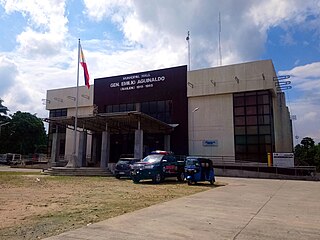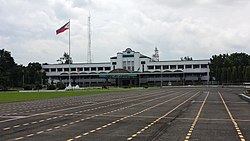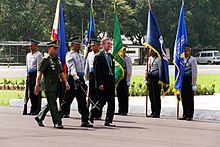
Emilio Aguinaldo y Famy was a Filipino revolutionary, statesman, and military leader who is the youngest president of the Philippines (1899–1901) and became the first president of the Philippines and of an Asian constitutional republic. He led the Philippine forces first against Spain in the Philippine Revolution (1896–1898), then in the Spanish–American War (1898), and finally against the United States during the Philippine–American War (1899–1901).

The Philippine Constabulary was a gendarmerie-type military police force of the Philippines from 1901 to 1991, and the predecessor to the Philippine National Police. It was created by the American occupational government to replace the Spanish colonial Guardia Civil, happened on the 19th century history of the Philippines. It was the first of the four branches of the Armed Forces of the Philippines. On January 29, 1991, it was merged with the Integrated National Police to form the Philippine National Police.

Quezon City, also known as the City of Quezon and Q.C., is the most populous city in the Philippines. According to the 2020 census, it has a population of 2,960,048 people. It was founded on October 12, 1939, and was named after Manuel L. Quezon, the second president of the Philippines.

Pasig, officially the City of Pasig, is a highly urbanized city in the National Capital Region of the Philippines. According to the 2020 census, it has a population of 803,159 people.

San Juan, officially the City of San Juan, is a 1st class highly urbanized city in the National Capital Region of the Philippines. According to the 2020 census, it has a population of 126,347 people. It is geographically located at Metro Manila's approximate center and is also the country's smallest city in terms of land area.

Cainta, officially the Municipality of Cainta, is a 1st class urban municipality in the province of Rizal, Philippines. According to the 2020 census, it has a population of 376,933 people.

Camp General Rafael T. Crame is the national headquarters of the Philippine National Police (PNP) located along Epifanio de los Santos Avenue (EDSA) in Quezon City. It is situated across EDSA from Camp Aguinaldo, the national headquarters of the Armed Forces of the Philippines (AFP). Prior to the establishment of the civilian PNP, Camp Crame was the national headquarters of the Philippine Constabulary, a gendarmerie-type Military police force which was the PNP's predecessor.

Tanay, officially the Municipality of Tanay, is a 1st class municipality in the province of Rizal, Philippines. According to the 2020 census, it has a population of 139,420 people.

Baras, officially the Municipality of Baras, is a 4th class municipality in the province of Rizal, Philippines. According to the 2020 census, it has a population of 87,637 people.

General Emilio Aguinaldo, officially the Municipality of General Emilio Aguinaldo, is a 5th class municipality in the province of Cavite, Philippines. According to the 2020 census, it has a population of 23,973 people.

Santolan–Annapolis station, also simply known as Santolan station, is an elevated Metro Rail Transit (MRT) station located on the MRT Line 3 (MRT-3) system in Quezon City. It is the ninth station for trains headed to North Avenue and the fifth station for trains headed to Taft Avenue. The station is named after the streets it is situated in between Santolan Road and Annapolis Street, and near the eastern San Juan–Quezon City boundary.

The Roman Catholic Diocese of Cubao is a diocese of the western Latin Church of the Catholic Church in district of Cubao in Quezon City, in northern Metro Manila, Philippines. The diocese was created by Pope John Paul II on June 28, 2003 from the ecclesiastical district of Cubao of the Roman Catholic Archdiocese of Manila. It was canonically erected on August 28, 2003, with the installation of Honesto Flores Ongtioco as the first Bishop of Cubao. The Blessed Virgin Mary, under the title Immaculate Conception, is the principal patroness of the diocese.

Greenhills is an administrative division in eastern Metro Manila, the Philippines. It is an urban barangay in San Juan and is the largest barangay in the city, covering a total area of 2.09 square kilometers (209 ha) that spans over a third of San Juan's total land area.

Katipunan Avenue is a major avenue in Quezon City, Metro Manila, Philippines. It runs in a north–south direction from the University of the Philippines Diliman, intersecting with Tandang Sora Avenue at its northernmost point, down to the Manila Philippines Temple of the Church of Jesus Christ of Latter-day Saints, intersecting with White Plains Avenue at its southernmost point.

Ortigas Avenue is a 12.1 km (7.5 mi) highway running from eastern Metro Manila to western Rizal in the Philippines. It is one of the busiest highways in Metro Manila, serving as the main thoroughfare of the metro's east–west corridor, catering mainly to the traffic to and from Rizal.

Colonel Bonny Serrano Avenue, formerly named and still colloquially known as and referred to as Santolan Road, is a major east–west thoroughfare in the Eastern Manila District of Metro Manila, Philippines, between San Juan and Quezon City. It forms the northern limit of San Juan and the southern limit of Quezon City's New Manila district. It also links the PNP headquarters in Camp Crame with the AFP headquarters in Camp Aguinaldo. The avenue runs from the border of barangays Corazón de Jesús, St. Joseph (Halo-Halo), Pasadena, and Little Baguio in San Juan to barangays Libís and Blue Ridge B near the Quezon City-Marikina border in the east. It was named after the decorated Korean War hero, Venancio "Bonny" Serrano.

The following is an alphabetical list of articles related to the Philippine capital region of Metro Manila.

Socorro is a barangay located in Quezon City, Philippines, within the commercial district of Cubao. As of the 2019 census, the barangay has a population of 25,073 people. The barangay is home to Araneta City and Smart Araneta Coliseum, one of the largest indoor arenas in the world.

Circulo Verde is a mixed-use development in Quezon City, Metro Manila, the Philippines. It is a primarily residential enclave on a meander of the Marikina River in the village of Bagumbayan on Quezon City's border with Pasig. The 12.47-hectare (30.8-acre) riverfront community is a redevelopment of the former cement plant owned by Concrete Aggregates Corp., a subsidiary of Ortigas & Company. It is one of the four major estates owned and developed by the company in Metro Manila, which in 2019 maintained a combined land bank of 50 hectares across the Eastern Manila cities of Mandaluyong, Pasig and Quezon City.
























